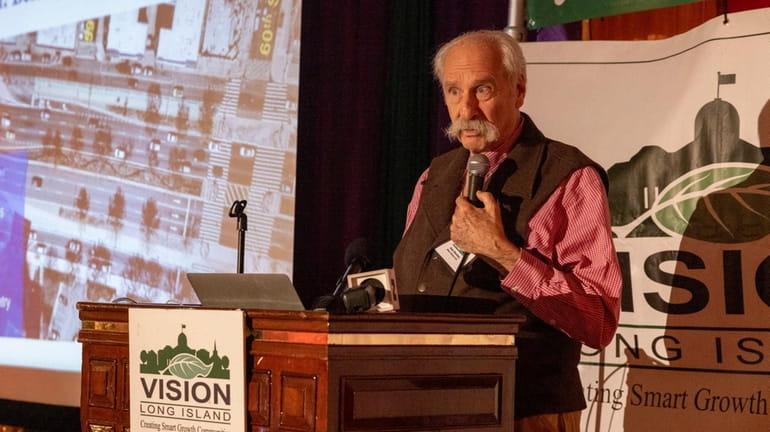Walkability expert touts traffic safety measures for Long Island civic and government leaders

Dan Burden speaks at the Complete Streets summit on Thursday in Hicksville. Credit: Howard Schnapp
A national walkability expert who helped create safer streets in over 3,500 cities nationwide urged Long Island government and elected leaders to adopt “people-first” planning models to slow down drivers and make streets safer for cyclists and pedestrians.
Dan Burden, of the group Blue Zones, spoke in front of over 200 people at a Hicksville Complete Streets event hosted by Vision Long Island, where the focus was on encouraging biking and walking while revamping roads to meet the needs of all users, including populations such as the elderly, disabled and people who don’t have access to cars.
The audience consisted of community leaders, transportation advocates and business owners — gathered to learn about how “complete streets” design will benefit their community. The Complete Streets Act, which became state law in 2011 for transportation projects that receive federal and state funding, requires street designs and operations to account for the safety of all users.
The design approach has reduced accidents in cities and builds a healthier society, Burden said.
“Human beings are fragile, and they have frailties," he said. "Whether they're driving a car or walking, their abilities need to be honored every time we engineer a road. And if we don't do that, we're failing the most basic science that we've been taught.”
“If we built what we value — we care about kids, we care about ourselves and our elders — then we will start making the right decisions. But what we've been building has not been to honor those things," he added.
Some of the measures that have successfully slowed down drivers include adding trees, sidewalks, buffered and protected bike lanes, roundabouts and narrower car lanes, Burden said.
For pedestrians, raised and widened crosswalks, median islands and more ramps per corner provide safer access.
Vision Long Island’s director, Eric Alexander, said 40 such traffic projects were undertaken in less than two decades.
“We don’t need them to be trophy prizes — we need them to be normative,” Alexander said, stressing that funding needs to be prioritized for these projects.
During the summit, Vision Long Island focused on seven areas that typify common roadway issues found throughout Long Island: West Merrick Road in Valley Stream, Fulton Avenue in downtown Hempstead, Broadway in Hicksville, New York Avenue in Huntington Station, Deer Park Avenue in Deer Park, Middle Country Road in Coram and Carleton Avenue in Central Islip.
Elected officials and community leaders also pinpointed crash hot spots in their district.
Nassau County Legis. Siela Bynoe (D-Westbury) zeroed in on two traffic incidents on Woodfield Road near Melvin Avenue in Lakeview last year.
“We did go and do some immediate remediation temporarily but we know that there's a permanent solution and so we're working toward achieving that,” Bynoe said.
“There’s also a plethora of similar issues I’m concerned about in Hempstead,” Bynoe told Newsday.
Suffolk County Legis. Jason Richberg (D-West Babylon), the minority leader, noted that a local ice cream shop in West Babylon, near Southern State Parkway exit 36, is notable not just for great frozen treats but also because of the sheer number of crashes there.
“Every year there's an accident at that ice cream shop," he said. Months ago, a car ran "straight into it" on a nice day. "The owner said to me, it's a miracle that nobody was either standing in front or inside or working at the front desk.”
Other Long Island residents took time to air their frustrations about the lack of critical infrastructure.
Gayle Lynch-Bailey, president of the Middle Island Civic Association, said her neighborhood lacks sidewalks. “Sidewalks don’t mean the cities, folks; it means safety — and we need that desperately.”
It’s also important to keep in mind older populations that are currently outpacing the younger generation, said Bernard Macias, associate state director of the AARP.
“We do need to look through the lens, for all the work that we do, through that 55-plus community,” he said.
